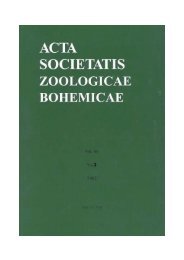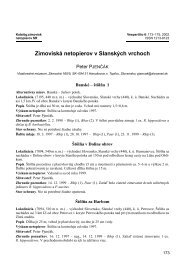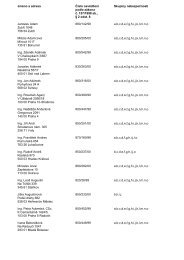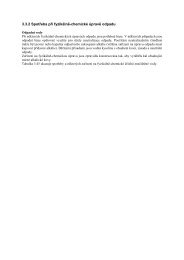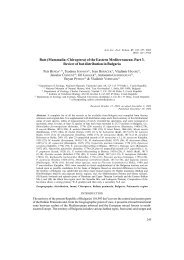Ivo Chlupáč – Vratislav Kordulewith the Ptychagnostus atavus and particularly with the P.punctuosus Zones (sensu Robison 1984), i.e. the higherpart of the major Paradoxides paradoxissimus trilobitebiozone of the Baltic scheme.The latest described arthropods come from the Ellipsocephalushoffi – Rejkocephalus Zone, especially fromthe locality at Rejkovice, where Helmetia? fastigata sp. n.,Tuzoia sp., Forfexicaris? sp. and some other problematicalremains were found in association with Ellipsocephalushoffi (Schlotheim), Rejkocephalus rotundatus (Barrande),frequent small hyolithids (often with opercula), brachiopodsLindinella kordulei Mergl et Šlehoferová, rareKonicekion tix Šnajdr, and few other fossils. Ichnofossils(Mikuláš 2000) belong to Skolithos, Planolites, Teichichnusand Daedalus. The E. hoffi – Rejkocephalus Zonemight correspond to the lower part of the Paradoxidesforchhammeri Zone of the Baltic zonal scheme (the correlation,however, is still problematic).Rare remains tentatively reported as Forfexicaris? sp. fromthe Skryje-Týřovice Cambrian in the NW flank of the Barrandian,belong to the Eccaparadoxides pusillus Zone of theSkryje Shale, corresponding roughly to the lower (but not thelowest!) part of the Jince Formation of the Jince area.To summarize, the representatives of Tuzoia and alliedtuzoid arthropods occupy together with thin-shelled remainsdesignated as Forfexicaris? sp. a rather long stratigraphicinterval within the Middle Cambrian, particularlyin its higher part correlatable with the Paradoxides paradoxissimusZone. Rare finds of Helmetiids and other exceptionalarthropods occurring in later strata with theindex trilobite Ellipsocephalus hoffi can be correlated withthe lower part of the Paradoxides forchhammeri Zone ofthe Baltic scheme.Palaeoecological notesAll the arthropods described here come from the MiddleCambrian siliciclastic rocks, namely from siltstonesand silty-clayey shales. They occur in sequences markedby alternating influx of silt-clay-sand (greywacke) materialin irregular intervals of mm to tens of cm thickness(lithologic characteristics of the Jince Formation: Kukal1971, Havlíček and Kukal in Chlupáč et al. 1998). Interbedsof dark grey or grey-green greywackes are locallyfrequent but they are persistent on individual outcrops. Describedremains of arthropods derive exclusively fromshale or siltstone beds, they were newer found ingreywacke layers. This suggests that the presence of sucharthropods corresponds to intervals of more stable conditionsreflected in the fine-grained sedimentation.Frequent remains of marine benthic animals, namelylarge polymerid trilobites and less common but typicalechinoderms (carpoids, eocrinoids, edrioasteroids) and hyolithids,accompany the described arthropods. Agnostidsare also present, though they are not dominant. Accordingto the scheme established for the Jince Middle Cambrianby Fatka (2000) our arthropods belong in the shallow-waterlife zone, dominated by polymerid trilobites.The ichnofossils marked by common epi- andintrastratal traces indicate the widely distributed shallowwaterenvironment of the Cruziana and/or Skolithos-Cruziana Ichnofacies (comp. Mikuláš 2000).The co-occurrence with complete exoskeletons of smalland large trilobites and non- or incompletely disarticulatedechinoderms and the preservation of even thin shields excludeany longer transport of the studied remains. In ourview, the tuzoiid, helmetiid and probably also proboscicaridarthropods could be regarded as nektobenthic animalswhose habit might be compared with some trilobites: theymight be scavengers or filter-feeders rather slowly movingabove the sea floor (cf. consideration of Helmetia by Briggsin Conway-Morris et al. 1982).A different habit can be presumed in Forfexicaris? sp.with very thin cuticle. It might represent a pelagic elementless dependent on bottom conditions and shallow-waterrealms (this can be supported by its occurrence in theSkryje Shale in association with more common agnostids).ConclusionRare remains of large non-trilobite arthropods in theMiddle Cambrian of Bohemia are confined to the laterphase of the marine transgression cycle.The described arthropods show clear resemblances toother, particularly North American, Middle Cambrian faunas(especially the Burgess Shale of British Columbia andcoeval strata of Utah). Their rare occurrence and incompletepreservation, however, prevent adequately based palaeogeographicaland biostratigraphical conclusions from beingdrawn. The relationships indicate open migration possibilitiesand faunal exchange over vast areas, probably even betweenLaurentia and the presumed shelves of Gondwana, towhich also the Barrandian area belonged.All described arthropods lived in marine environmentwith marked terrigenous influx. However, their remainsare contained in finer-grained siltstone and combined siltstone-claystonelayers pointing to temporary intervals ofrelative stable and quieter sedimentation. These conditionscould be generally more suitable for preservation of thincarapaces of described arthropods. The occurrence of Helmetia?,Tuzoia, and Forfexicaris? in siltstones of the Ellipsocephalushoffi Zone with less diversified benthos mayindicate a tolerance to conditions of decreased salinity.A nektobenthic habit and a rather shallow-water environmentare presumed for the discussed arthropods (exceptForfexicaris? sp. as a possible pelagic element).Biostratigraphic conclusions are premature, but theavailable finds come mostly from the upper part of theJince Formation, where some decrease of diversity in benthicfauna is already observed. The correlation with themiddle and upper parts of the Paradoxides paradoxissimusZone (most finds) and possibly with the lowest part of theParadoxides forchhammeri Zone (the youngest finds) ofthe Baltic biostratigraphic scheme is most probable.178
Arthropods of Burgess Shale type from the Middle Cambrian of Bohemia (Czech Republic)Acknowledgements. The authors are indebted to RNDr. M.Široký, Ing. L. Mandík and Mr. M. Szabad for offering the specimensfrom their private collections for study. Dr. R. J. Prokop (NationalMuseum, Prague) gave valuable information on echinoderms and evaluationof Pilocystites primitius Barrande and supported, together with Dr.V. Turek, this study in the National Museum, Prague. Our particularthanks go to W. D. J. Rolfe (Edinburgh) for critical reading the manuscript.Doc. Dr. O. Fatka (Institute of Geology and Palaeontology,Charles University) helped with useful advice as a reviewer of themanuscript. Mr. R. J. Duda (Charles University) carefully made thephotographs.ReferencesBarrande J. (1852): Système silurien du centre de la Bohême. Vol. I.Recherches géologiques. Prague, Paris.– (1887): Système silurien du centre de la Bohême. Vol. VII. Cystidées.Prague.Beaver H. H. et al. (1967): Treatise on Invertebrate Paleontology. Part S,Echinodermata 1. Geol. Soc. Amer., Univ. Kansas.Briggs D. E. G. (1977): Bivalved arthropods from the Cambrian BurgessShale of British Columbia. Palaeontology, 20, 595–621.Briggs D. E. G., Erwin D. H., Colier F. J. (1994): The fossils of theBurgess Shale. Smithsonian Institution Press.Brooks H. K., Caster K. E. (1956): Pseudoarctolepis sharpi, n. gen., n. sp.(Phyllocarida), from the Wheeler Shale (Middle Cambrian) of Utah.J. Paleont., 30, 1, 9–14. Tulsa.Chlupáč I. (1999): Barrande’s stratigraphic concepts, palaeontologicallocalities and tradition – comparison with present state. J. Czech Geol.Soc., 44, 1–2, 3–30.Chlupáč I. ed. (1968): Lexique stratigraphique international. Fasc. 6b1.Massif de Bohême. IUGS, Centre Nat. Rech. Sci., 452 pp. Paris.Chlupáč I., Havlíček V., Kukal Z., Kříž J., Štorch P. (1998): Palaeozoicof the Barrandian (Cambrian to Devonian). 183 pp. Czech Geol.Surv., Praha.Conway Morris S., Whittington H. B., Briggs D. E. G., Hughes C. P.,Bruton D. L. (1982): Atlas of the Burgess Shale. PalaeontologicalAssoc.Fatka O. (2000): Das Mittlere Kambrium bei Jince, Tschechische Republik.Europäische Fossillagerstätten (G. Pinna, D. Meischner eds).21–23. Springer.Fatka O., Kordule V. (1992): New fossil sites in the Jince Formation(Middle Cambrian, Bohemia). Věst. Čes. geol. Úst., 67, 1, 47–60.Glaessner M. F. (1979): Lower Cambrian Crustacea and annelid wormsfrom Kangaroo Island, South Australia. Alcheringa, 3, 21–31.Hahn G., Brauckmannn C. (1977): Phyllocariden-Reste (Crustacea) ausdem deutschen Kulm (Unter-Karbon). Senckenberg. lethaea, 58,81–90.Hou X. G. (1987): Three new large arthropods from Lower CambrianChengjiang, eastern Yunnan. Acta Palaeont. Sinica, 26, 3, 272–285.– (1999): New rare bivalved arthropods from the Lower CambrianChengjiang Fauna, Yunnan, China. J. Paleont., 73, 1, 102–116. Tulsa.Hou X. G., Bergström J. (1997): Arthropods of the Lower CambrianChengjiang fauna, southwest China. Fossils Strata, 45, 116 pp. Oslo.Jaekel O. (1899): Stammesgeschichte der Pelmatozoen. 1. Thecoidea undCarpoidea. 442 pp. Springer Berlin.Kordule V. (1996): Význam některých méně známých fosiliferníchlokalit pro stratigrafii jineckého souvrství v českém středním kambriu.Věst. Čes. geol. Úst., 71, 1, 37–49.Kukal Z. (1971): Sedimentology of Cambrian deposits of the Barrandianarea (Central Bohemia). Sbor. geol. Věd, Geol., 20, 53–100. Praha.Lipold M. V., Krejčí J. (1860): In: Verhandlungen der k. k. Geol. Reichsanstalt,Sitzungsbericht vom 24. April, 88–91. Wien.Mergl M., Šlehoferová P. (1991): Middle Cambrian inarticulate brachiopodsfrom Central Bohemia. Sbor. geol. Věd, Paleont., 31,67–102. Praha.Michálek M. (1978): Němý svědek. Mladý svět, 20, 44 pp. Praha.Mikuláš R. (2000): Trace fossils from the Middle Cambrian of the Barrandianarea (Central Bohemia, Czech Republic). Czech Geol. Surv.Spec. Papers, 12, 29 pp. Praha.P’an Kiang (1957): On the discovery of Homopoda from South China.Acta Palaeont. Sinica, 5, 523–526.Raymond P. (1935): Leanchoilia and other Mid-Cambrian Arthropoda.Bull. Mus. Compar. Zoology, 76, 205–230.Resser Ch. E. (1930): New Lower and Middle Cambrian Crustacea. U. S.Nat. Mus., Proc. 76, 9, 1–18.Resser Ch. E., Howell B. F. (1938): Lower Cambrian Olenellus Zone ofthe Appalachians. Bull. Geol. Soc. Amer., 49, 195–248.Robison R. A. (1984): Cambrian Agnostida of North America and Greenland.Part I. Ptychagnostidae. Univ. Kansas Paleont. Contrib., 109,1–60.Robison R. A., Richards B. C. (1981): Larger bivalve arthropods from theMiddle Cambrian of Utah. Univ. Kansas Paleontol. Contrib., 106,1–28. Lawrence.Rolfe W. D. I. (1962): Two new arthropod carapaces from the BurgessShale (Middle Cambrian) of Canada. Breviora Mus. Compar. Zoology,160, 1–9. Cambridge, Mass.– (1969): Phyllocarida. In: Moore R. C., Teichert C. (eds) Treatise oninvertebrate paleontology, Part R, Arthropoda 4, Vol. 1, R296-R331.Geol. Soc. Amer., Univ. Kansas. Boulder.Simonetta A. M., Delle Cave L. (1975): The Cambrian non trilobitearthropods from the Burgess Shale of British Columbia. PalaeontographicaItalica, 69, 1–37.Walcott Ch. D. (1912): Cambrian geology and paleontology II. No. 6.Middle Cambrian Branchiopoda, Malacostraca, Trilobita, andMerostomata. Smithsonian Miscellaneous Collections, 57, 6,145–228.– (1931): Addenda to descriptions of Burgess Shale fossils. SmithsonianMiscellaneous Collections, 85, 3, 1–46. Washington.Yuan Jin-Liang, Zhao Yuan-Long (1999): Tuzoia (bivalved arthropods)from the Lower-Middle Cambrian Kaili Formation of Taijiang,Guizhou. Acta Palaeont. Sinica, 38, Suppl., 91–94. Beijing.Handling editor: Petr ŠtorchExplanation of platesPlate I⇒Tuzoia sp., Jince Formation (upper part), Vinice near Jince (A-C),Rejkovice (D).A, B, C – incomplete right carapace valve VK40 with partly preservedlateral ridge, posteroventral part and doublure; (B – enlarged figure withoutthe anterior part, C – enlarged anterior part with partly exposed doublure);D – fragment of doublure SZ169.Plate II⇒ ⇒Tuzoia sp., Jince Formation near Jince (except F – Velká Bába near Hostomice).A, B, C, D – incomplete right carapace valve VK41, Vinice; A – enlargedposterodorsal part, B – enlarged anterior part, C – enlarged dorsal part, D –the overall view showing the covered median part and broken antero- andposteroventral parts); E – fragmentary dorsal part of the right carapace valvewith posterior edge, L36484; F – fragmentary specimen SZp5964, a toothlikeprojection is probably a hyolithid shell attached to the Tuzoia fragment;G – fragment of a large specimen showing the typical reticulate sculpture,L36482; H – two fragmentary and approached carapace valves showingconfiguration of the dorsal margins and increasing density of reticulatesculpture near the broken lateral ridges, L36481.Plate III⇒ ⇒ ⇒Large tuzoiid arthropod (n. gen.), Jince Formation, Vinice near Jince,Paradoxides gracilis Zone. L36595 (coll. M. Široký), maximum diameter227 mm.A, B – overall views in different light, with different sculpture and imprintedremains of paradoxidid trilobites; C – strongly enlarged part ofthe left medium sector showing the marked difference between the “tuzoiid”polygonal sculpture and the thicker and pitted parts.All photos R. J. Duda179



